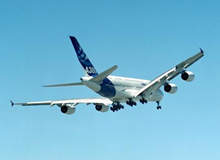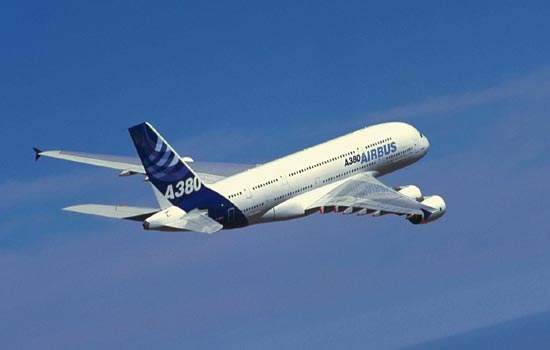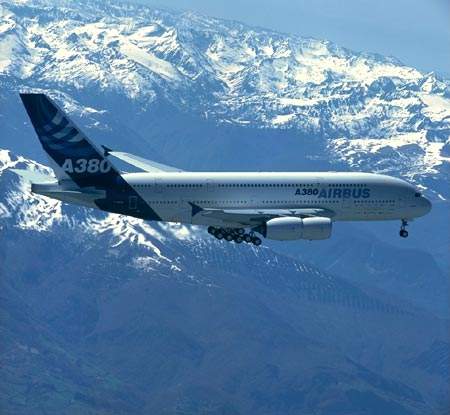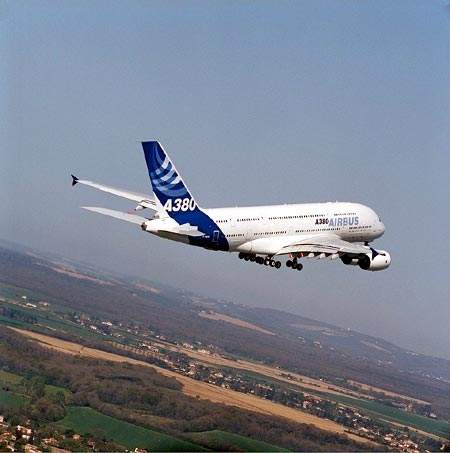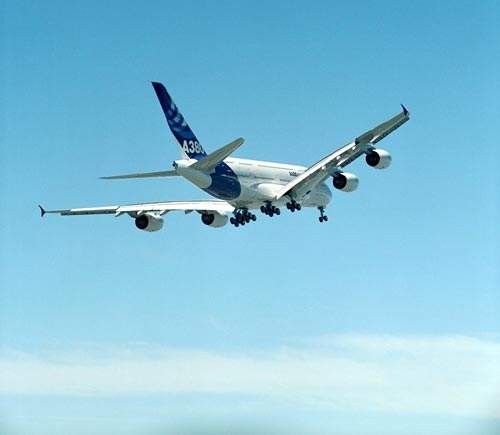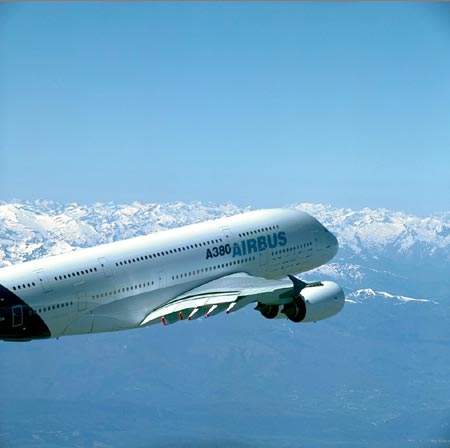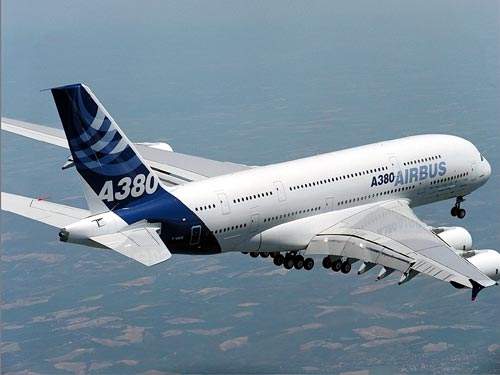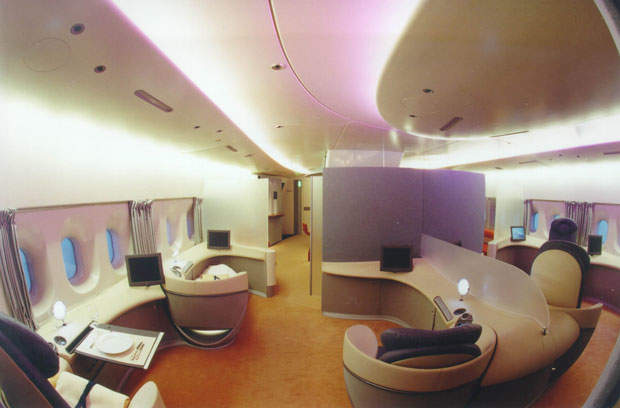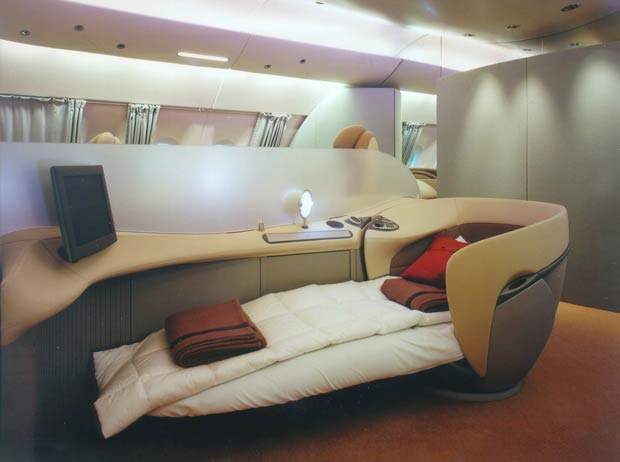Airbus’s superjumbo, the A380, is the world’s first twin-deck, twin-aisle airliner. Advantages of the A380 include lower fuel burn per seat and lower operating costs per seat.
The 555 seat Airbus A380-800, with a non-stop range of 8,000nm, was launched in December 2000. The aircraft began production in January 2002. The first flight (with Rolls-Royce engines) took place from Blagnac Airport, Toulouse, in April 2005. More than 100 test flights were completed before its first commercial flight was carried out by Singapore Airlines, from Singapore to Sydney, which took place on 25 October 2007.
Other test flights included one in October 2005, a third in November 2005, fourth in February 2006 and fifth in May 2006. One test aircraft took part in the flight display at the Farnborough International Airshow in July 2006.
Powered by Rolls-Royce Trent 900 engines, the A380 received joint European Aviation Safety Agency (EASA) and Federal Aviation Administration (FAA) Type Certification on 12 December 2006. In January 2007, Airbus became the first company to receive ISO 14001 environmental certification for its products. In March 2007, one A380 test aircraft flew to New York and one to Los Angeles, the first transatlantic flights of the A380.
In February 2012, the EASA ordered checks for possible cracks inside the aircraft’s wings on the entire global fleet of Airbus A380 superjumbo jets, under its second airworthiness directive. Aircraft which completed 1,216 to 1,384 flights were ordered for inspection. The EASA has also expressed concerns over the safety of aluminum rivets in the fuselage and suggested replacing them with titanium fasteners.
Assembly of the world’s first twin-deck, twin-aisle airliner
Airbus Industrie is a consortium formed by EADS and BAE Systems. EADS, the European Aeronautic Defence and Space Company, was formed by a merger of Aerospatiale-Matra of France, Daimler-Chrysler Aerospace of Germany and CASA of Spain (former members of Airbus). In October 2006, BAE Systems completed the sale of its shareholding to EADS, which is now the sole owner of Airbus.
Airbus’s A380 aircraft sections were transported from sites in Broughton (UK), Hamburg (Germany), Puerto Real (Spain) and St Nazaire (France) in a specially constructed huge roll-on / roll-off vessel, the ‘Ville de Bordeaux’, built by the Jinling Shipyard in Nanjing, China.
The vessel was launched in July 2003 and had the largest water stern door (22m x 14m) ever built on a Ro Ro vessel. It took the components to Bordeaux. From there they were transported via specially constructed barges up the Garonne River and then transferred by road trailer to the final assembly line in Toulouse. A second Ro Ro vessel, the City of Hamburg, built at ST Marine in Singapore, was delivered on 4 December 2008, with another in early 2009.
Structure and construction of the superjumbo aircraft
In order to minimise the unladen weight, the Airbus A380 structures incorporate a range of new materials, as used on the A318 and A340 families of aircraft.
Carbon fibre-reinforced plastic is used for the central box of the wings, the horizontal stabilisers (which are the same size as the Airbus A310 wing), the fin, the rear fuselage section and for ceiling beams.
A new material, Glare, which is highly resistant to fatigue, is used in the construction of the panels for the upper fuselage. The aluminium and fibreglass layers of Glare do not allow propagation of cracks. It is much lighter than conventional materials and represents a weight saving of about 500kg in construction. Impact-resistant thermoplastics are used on the wing leading edge. The aircraft has 16 wing spoilers supplied by Patria of Finland.
The A380 incorporates two rather than three Eaton Corporation hydraulic systems, with increased hydraulic pressure of 5,000 pounds per square inch instead of a standard 3,000psi.
The A380 is a member of the Airbus Flight Operational Commonality family with similar flight decks and operating procedures across the A320, A330 and A340 aircraft, providing easy crew transition training, cross crew qualification and mixed fleet flying.
Thales Avionics developed and supplies the eight high-format, high-resolution, 150mm×200mm (6in×8in) liquid crystal displays and the digital head-up display (HUD). Honeywell, US, provides the next-generation flight management system, which has increased data handling speed and a graphical user interface with pop-up menus and cursor control, rather than a text-based interface. Honeywell also supplies the satellite communication system. Goodrich supplies air data systems.
Rockwell Collins supplies communications systems, including VHF and HF radios and multimode receivers. Northrop Grumman provides the LTN-101E inertial navigation system. Smiths Industries provides the video management unit which includes the display from cockpit door and cabin surveillance systems. L-3 Aviation Recorders of Florida provides flight data and cockpit voice recorders.
Twin-deck layout aboard the A380 aircraft
The A380 has twin-aisle cabins on the upper and lower decks, with 49% more floor space for a 35% greater seating capacity. A three-class layout provides 555 seats. A typical upper deck layout provides 96 business and 103 economy-class seats. The main deck provides 22 first-class seats and 334 economy-class seats.
Two stairwells link the passenger decks. A lifting system between passenger decks provides access for passengers with limited mobility. There is also a cargo hoist linking the two passenger decks.
The size of the A380 makes possible a number of configurations and passenger facilities. Singapore Airlines (launch customer) has a configuration for 471 passengers – 12 first-class ‘suites’ and 311 economy seats on the main deck, 60 business class seats and 88 economy seats on the upper deck.
There are eight full-size doors on either side of the aircraft. On both sides, there are two doors on the main deck and one door on the upper deck forward of the wing, which can be used simultaneously for embarking or disembarking passengers. For speedy baggage transfers, two hold loading belts, one at the forward end and one at the rear end under the fuselage, can be used simultaneously.
Matsushita Avionics Systems was selected to supply its next-generation eX2 in-flight entertainment system.
Engines used on Airbus’s A380
The aircraft is equipped with four 70,000lb thrust engines, either the Rolls-Royce Trent 900 or the General Electric / Pratt & Whitney Engine Alliance GP7200. Rolls-Royce delivered the first Trent 900 engine in February 2004 and it made a successful first flight on an A340-300 test-bed in May 2004. The first test-bed flight of GP7200 was successfully completed on 4 December 2004.
Goodrich supplies the engine sensor system for the Trent 900 and Ametek the sensor system for the GP7200. BAE Systems Controls and Hispano-Suiza provides the FADEC (full authority digital electronic control) system for the GP7200.
The take-off length is 2,900m at maximum weight at sea level, ISA +15° conditions and the initial cruise altitude 35,000ft. The aircraft complies with the noise emission limits of ICAO (Chapter 3, Schedule 16) for overfly, approach and side-on manoeuvres and the stricter regulations of London Heathrow Airport, concerning take-off and landing. This enables aircraft operations at night.
There are ten fuel tanks with a capacity of 131,000l of fuel. Refuelling can be carried out in 40 minutes.
The 22-wheel Goodrich landing gear consists of two under-wing struts, each with four wheels, two central under-fuselage struts, each with six wheels, and a twin nose wheel. Each landing gear supports about 167t. Messier-Dowty supplies the nose landing gear with 350bar hydraulic pressure and Messier-Bugatti the braking and steering systems. Smiths Aerospace supplies the landing gear extension and retraction system. The load on the airport runways and aprons are of similar magnitude to that of a 747. ELDEC of Lynnwood, Washington, provides the landing gear proximity sensing system.
The aircraft can complete a 180° turn within a width of 56.5m, which is within the 60m width dimension of standard runways. Maximum operating speed is Mach 0.89 and the range is 15,000km or 8,000nm with the maximum number of passengers.
The turnaround time at the airport terminal, including passenger disembarking, cleaning, restocking and embarking the passengers for the next flight, is a minimum of 90 minutes.
A380-800F freighter variation of the popular airliner
The A380 is the first major commercial airliner programme with a freighter version being co-developed as part of the new aircraft launch. The A380-800F can transport 150t of freight using standard, interlineal containers and pallets. The full payload range of the A380-800 F is 5,600nm. Launch customers were FedEx (ten aircraft) and Emirates (two) with the first deliveries scheduled for 2012, behind the original schedule of 2008.
The upper deck of the A380-800F version is 5.92m wide and can hold 17 pallets. The main deck’s maximum width is 6.58m – it can accommodate 28 pallets.
Other probable derivatives of the A380 are an extended range version, A380-800R and a stretched version A380-900.
Initial Airbus A380 orders and deliveries
The first A380 was delivered to Singapore Airlines (SIA) on 15 October 2007, entering service on 25 October with a flight from Singapore to Sydney. SIA sold the tickets for the flight by online auction on eBay, with proceeds going to charity.
A second A380 was delivered to SIA in January 2008 and a third in March 2008. SIA began scheduled A380 flights between Singapore and London on 18 March 2008.
The first flight with the General Electric / Pratt & Whitney Engine Alliance GP7200 was in August 2006 and the A380, powered by the GP7200, received FAA and EASA certification in December 2007. Launch customer for the A380 with this engine was Emirates, with the first delivery in July 2008. Emirates launched the A380 on its Dubai to New York route in August 2008.
First delivery to Qantas was in September 2008. The airline commenced A380 services in October 2008. Airbus delivered 13 A380 aircraft in 2008 – five SIA, three to Qantas and four to Emirates.
Air France took delivery of its first Airbus A380 on 30 October 2009. It received the aircraft in a delivery ceremony which took place in Hamburg, Germany. Singapore Airlines was delivered the 11th A380 Airbus and Lufthansa’s second A380 in July 2010.
The 31 delivered A380s which are in service have completed up to 156,000 revenue flight hours during 17,000 flights. They have carried more than six million passengers to 20 international destinations.
Recent orders of the Airbus A380 internationally-used aircraft
As of February 2012, firm orders for 253 A380 aircraft were received with 71 delivered.
In January 2012, Hong Kong Airlines confirmed an order for ten A380s with an estimated value of $3.8bn. On 17 November 2009, Air Austral ordered two Airbus A380s to accommodate 840 passengers in a single-class configuration.
In June 2007, Air France ordered an additional two, Emirates an additional eight and Qatar Airways an additional three aircraft. As of December 2008, 14 aircraft had been delivered.
In all, 25 orders had been received for the cargo version but, in November 2006, Federal Express announced the cancellation of its order for ten aircraft, citing delays in delivery dates as the cause and International Lease Finance has converted its order to the passenger version.
In March 2007, UPS announced its intention to cancel the freighter order. Airbus decided to halt the freighter programme until delays to the passenger version have been resolved.
In November 2007, the first order for the A380 Flying Palace, the VIP variation, was placed by HRH Prince Alwaleed bin Talal bin Abdulaziz Alsaud.
In February 2008, an Airbus A380 made the first flight of a commercial airliner using a liquid fuel processed from gas, GTL (gas to liquids), under the company’s alternative fuel research programme. One engine was fuelled with a blend of 40% GTL and standard jet fuel, the other three with standard fuel.

